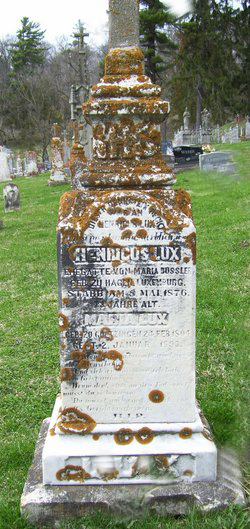The Lux family arrived in New York harbor on November 16, 1853. They were in Iowa by December 14 when Henricus purchased 144 acres in the northwest quarter of section 7, Tete des Morts Township, Jackson County, Iowa for $1600. This land bordered that of the Saint Donatus Catholic Church.
Tete des Morts, township, which in French means head of the dead, was named for the creek of that name. According to legend the name derived from the numerous skulls of Indians killed in a battle along the creek.

Unfortunately, we do not know how the Lux family traveled from New York City to Tete des Morts. We know they did not travel by wagon because in less than a month they were in Iowa. The most likely route would have been by railroad to Chicago and then on to Rockford, Illinois, the end of the line in 1853. Perhaps they purchased a team and wagon in Rockford which is 82 miles, about a seven day trip, from Dubuque, Iowa. The population of Dubuque in 1853 was about 3,300. The only way to cross the Mississippi River at Dubuque was by ferry. Then it would have taken another day to travel the 13 miles to Tete des Morts. 
I assume there was a house, either log or stone, already on the farm when Henricus purchased it. However, the price of the land seems high—about $11.10 and acre—when government land was selling for $1.25 an acre.
When the Lux family arrived at Tete des Morts , they found a log church that had been built in 1848 and dedicated to Saint Donatus of Muenstereifel, protector against lightning and storms. He was widely venerated in the Rhine Valley and in Luxembourg.
The Lux family had just arrival in Iowa when tragedy struck. Eleven year-old Jean Lux died January 26, 1854 and on March 3, fourteen year-old Henricus Junior died. They were the only sons of Henricus and Mary. It is not known what caused their deaths. On February 21, 1854 the oldest daughter, Theresa, married Johann Tritz. Theresa, died on January 30, 1857 aged only 24. Her grave in the Saint Donatus cemetery is unmarked.
In October 1855 daughter Mary Ann married Peter Theisen and in November daughter Susanna married Karl Hoffman, both in the little log church. Both couples lived to celebrate their 50th wedding anniversaries.
In the autumn of 1856 the church and parsonage with their contents burned. A new stone parsonage was soon built. The list of contributors includes H. Lux $4.90. The 42 acres belonging to the church were surveyed and it was noted that two of Lux’s fences stood on the church property.
The cornerstone of a new stone church and rectory was laid in April 1858. Donations for the new church included H. Lux $75.00, a substantial sum at that time. In 1859 a Catholic school, which met in the rectory, was organized.

The 1860 federal census’s agricultural schedule gives us a glimpse of the Lux family’s farming operation. The farm was valued at $4,000, of which ninety acres were improved–that is cultivated. The value of farming equipment was only $50. The livestock consisted of 5 horses, 3 milch cows, 2 oxen, 3 other cattle, 5 swine, all valued at $400. Produced the previous year was 120 bushels wheat, 50 bushels corn, 30 bushels oats, 15 tons hay, 100 bushels potatoes, $50 worth of fruit, 500 lbs. butter, value of animals slaughtered was $200. These numbers were about average for the community.

The first outdoor way of the Cross in America was built at Saint Donatus in 1861. Fourteen brick shrines line a winding path some 500 feet up the wooded hill behind the church. In 1866 a large four-story boarding school for girls, St. Mary’s Academy was built. The School Sisters of Notre Dame from Milwaukee supplied the school. H. Lux paid $30 to the church in 1869. This probably included money owed for previous years as he paid $5 pew rent in 1870.
Daughter Elisabeth married Peter Kummer in 1865 and daughter Mary Ann (yes, two daughters named Mary Ann) married Martin Mousel in 1869.
A continued drought killing trees was mentioned in the church chronicle in 1874, and a large cross was erected in the cemetery that year. Also in 1874, “Numerous deaths among the little children” but no cause was given.
A high school named Tete des Morts High School for young men was erected in 1875. Classes were held during the five winter months. A notation in 1875 reads “Towards the south and west boundary (of the church land) towards H. Lux, came a board fence on the one-half of the parish border line; the other half Lux must make and keep up. To make such fences is very expensive but exceedingly necessary.”
Henricus wrote his will in September 1875. He left his daughters, Susanna Hoffman, Marianne Theisen and Elisabeth Kummer each $800 to be paid after the death of his wife. To his daughter, Mary Mousel, he left the remainder of his estate both real (the farm) and personal. Henricus died May 8, 1876 at age 73 and was buried in the church cemetery where his grave marker still stands 144 years later.

Mary Lux was living on the farm in 1880 along with daughter Mary Mousel and her six children. Martin Mousel had died in 1877. Mary died January 2, 1894 at the age of 86 years.
Henricus and Mary are my great, great, grandparents, great grandparents of my grandmother, Catherine Kaiser Trausch. Many descendants of Henricus and Mary Lux live in Adams County, Nebraska, including families named Theisen, and Mousel.
Information about church was taken from the “Original Chronicle of the Parish of St. Donatus” translated from the original German by Arnold Toma in 1955.